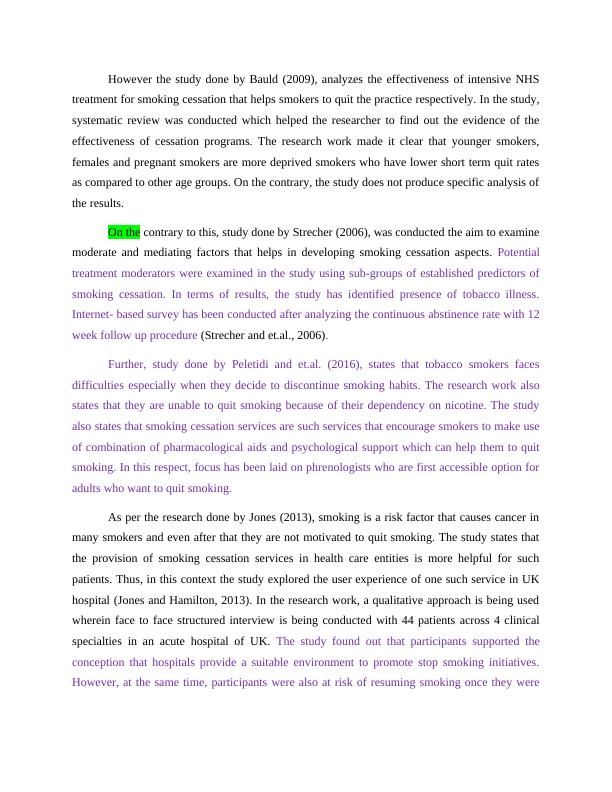Electronic cigarettes and smoking cessation in England
6 Pages1810 Words161 Views
Added on 2019-12-17
Electronic cigarettes and smoking cessation in England
Added on 2019-12-17
ShareRelated Documents
LITERATURE REVIEWIn order to evaluate and inform strategies for tobacco control, it is essential to carry outup-to-date tracking of national patterns of smoking as well as behavior associated with itscessation. Fidler and et.al. (2011), conducted a study on smoking and smoking cessation inEngland. The authors carried out a smoking toolkit study in which monthly, cross sectionalhousehold interviews were conducted with adults of above 16 years of age. The study wasconducted in England and recent ex-smokers were included in the research. As per the views ofauthors, a number of policy changes took place in UK since 2007. However, it was found that the number of smokers attempting to stop smoking increasedtemporarily after the smoke free legislation was introduced. It can be analysed that smokingcessation strategies significantly impacts adults if it is implied by law. Moreover, the authors alsofound that with the increase in the legal age for sale of cigarettes from 16 to 18 years, theprevalence of smoking was decreased. This suggests that smoking cessation programs, if coupledwith legislative changes, significantly impact the smoking cessation. The study done by Reid and et.al. (2010), states that people who have lower socio-economic status uses tobacco on higher rates and they are also less likely to quit smoking. Thus,in this respect the study conducted shows association between socio economic status and quittingrelated behaviours. In this research work, it is clearly identified that smokers with highereducation are more likely to intend to quit as early as possible. While organizing smokingcessation programs, it is crucial to ascertain potential effects on socio economic disparities. Thisis essential in adopting proper intervention for reducing smoking practices. According to Hiscock (2010), smokers belonging to lower socio- economic groups areless likely to be successful in quitting smoking when they come across such practices. In thestudy data were collection from smoking cessation service users. The study states that moreencouragement is required to be generated so that the practices of smoking can be minimized.Social inequalities are also observed in the same area and socio-economic groups are less likelyin the domain of quitting smoking. In the area of service delivery, there are certain causes ofinequalities that affects quitting practices.

However the study done by Bauld (2009), analyzes the effectiveness of intensive NHStreatment for smoking cessation that helps smokers to quit the practice respectively. In the study,systematic review was conducted which helped the researcher to find out the evidence of theeffectiveness of cessation programs. The research work made it clear that younger smokers,females and pregnant smokers are more deprived smokers who have lower short term quit ratesas compared to other age groups. On the contrary, the study does not produce specific analysis ofthe results.On the contrary to this, study done by Strecher (2006), was conducted the aim to examinemoderate and mediating factors that helps in developing smoking cessation aspects. Potentialtreatment moderators were examined in the study using sub-groups of established predictors ofsmoking cessation. In terms of results, the study has identified presence of tobacco illness.Internet- based survey has been conducted after analyzing the continuous abstinence rate with 12week follow up procedure (Strecher and et.al., 2006). Further, study done by Peletidi and et.al. (2016), states that tobacco smokers facesdifficulties especially when they decide to discontinue smoking habits. The research work alsostates that they are unable to quit smoking because of their dependency on nicotine. The studyalso states that smoking cessation services are such services that encourage smokers to make useof combination of pharmacological aids and psychological support which can help them to quitsmoking. In this respect, focus has been laid on phrenologists who are first accessible option foradults who want to quit smoking. As per the research done by Jones (2013), smoking is a risk factor that causes cancer inmany smokers and even after that they are not motivated to quit smoking. The study states thatthe provision of smoking cessation services in health care entities is more helpful for suchpatients. Thus, in this context the study explored the user experience of one such service in UKhospital (Jones and Hamilton, 2013). In the research work, a qualitative approach is being usedwherein face to face structured interview is being conducted with 44 patients across 4 clinicalspecialties in an acute hospital of UK. The study found out that participants supported theconception that hospitals provide a suitable environment to promote stop smoking initiatives.However, at the same time, participants were also at risk of resuming smoking once they were

discharged from hospital back to their previous environment. Hence, the results werecontradicted to a few extent. In addition to this, study done by Denman (2015), reflects that smoking increases thechanges of lung cancer; hence in this respect health care entities in UK have been emphasizingon public health campaigns so that people can continue to reduce smoking prevalence. Themethodology used in the study seems to be significant because that aids in evaluating localizedpublic health campaigns which aims to reduce smoking due to its impact on different parts of thebody. In the subsequent research work, smoking prevalence and radon levels prevailing in UKhave been mapped out at Primary Care Trust level. In addition to this, the study also extends theresearch work through using commercial socio- demographic database for the purpose ofestimating smoking prevalence in every postcode sector level. The study done by Mardle and et.al., (2012), contends that NHS stop smoking servicesprovide different options for support and counselling to all those who wish to quit smokingpractices. In the study, standardized interview with key personnel has been conducted with 400clients who have access to such service. In the research work, three local service evaluationswere carried out to describe the outcomes associated with different services. Hence, the researchhighlights different service structure, method of support and health care professional (who areinvolved in pharmacotherapy) and their role in successful quit. Thus, in the research workservice provision for smoking have been stated.On the other hand, Beard and et.al. (2016), states that changes have been prevailing insmoking activities due to use of electronic cigarette. Hence, in England smoking related issueshave been minimized. Time series analysis of population trends have been conducted in theresearch work. Survey is being carried out from participants who came from Smoking ToolkitStudy which involves repeated and cross sectional households of individuals aged 16 years andabove in England. In terms of results, it has been identified that success rates of smoking quittingattempts is increasing. However, no clear association has been found out between e- cigarettesand the rate of quit attempts.Supporting the content, study done by Matcham (2014) is also considered in the researchwork which states that NHS Stop Smoking Service is a cost effective method that enhances theprobabilities of smoking cessation. The study has been conducted with the help of underpinning

End of preview
Want to access all the pages? Upload your documents or become a member.
Related Documents
To Study the Effectiveness of Intensive Treatments for Smoking Cessation in Englandlg...
|11
|2455
|439
Designing a Health Promotion Program for Smoking Cessation among Manual Workerslg...
|5
|1029
|363
Smoking Cessation Assignment 2022lg...
|5
|843
|3
Real-world effectiveness of e-cigarettes when used to aid smoking cessationlg...
|8
|1703
|72
Research Literacy for Health Practice: Assignmentlg...
|7
|1670
|33
Smoking Cessation Project Proposallg...
|14
|2581
|269
